Big 'push' by France into tidal-stream electricity developments
3rd August 2013
Reporter - Bill Mowat
Big 'push' by France into tidal-stream electricity developments, spearheaded by a major Pentland Firth participant, is welcomed by the chairman of Scotland's most Northerly mainland port. Community-owned Gills Harbour Ltd lies adjacent to the Firth's 'tide-fields', while upgrade works at the Gills Bay site continue throughout this summer (2013).
France is making a determined push to harvest the energy of its tidal streams and perhaps challenge Britain's 'current' lead in this new 'horizontal hydro-electricity' field, with employment-creating developments already occurring on the other side of the English Channel.
A major shareholder in MeyGen Ltd, the consortium that aims to kick-off tidal stream electricity in the Pentland Firth's Inner Sound, off NE Caithness, as early as next year (2014), wants to build a second 'pilot plant' to harness the fast-flowing tides in the ten miles-wide strait between Alderney, in the Channel Islands and Normandy in Northern France.
The massive 200,000-employee French utility company GDF Suez, that holds a 45% stake In MeyGen Ltd's Inner Sound seabed license, aims to have a 'pilot array' of between three and six turbines of 1 MW each generating electricity in French waters between Normandy's Cherbourg Peninsula and the island of Alderney, in three years' time (2016).
This will be broadly similar in size and time-scale to MeyGen Ltd's planned initial �40+ million Inner Sound 6-turbine scheme on 30 metre-deep seabed leased from the Crown Estate lying between Gills Bay and the mid-Firth uninhabited Stroma Island.
A recent report in France claims that inshore seas off that country's coast holds only a fractionally less share of the European Union's 'exploitable' tidal-stream resources than Britain does; 42% as against 48%.
Last year GDF Suez completed the take-over of British-based utility International Power plc, MeyGen Ltd's key major UK shareholder at the time that its lease on seabed between Canisbay and Stroma Island was awarded by the UK's Crown Estate in late 2010.
Early this year (2013), two high-tech tidal turbine developers from the British Isles were separately taken over by French interests.
In January, Rolls Royce plc completed the sale of its Tidal Generation Ltd (TGL) subsidiary, presently based at Bristol, to France's engineering conglomerate Alstom. Its 1MW prototype turbine is under test throughout 2013 at the European Marine Energy Centre (EMEC) tidal site, off Eday, in the Orkney Islands.
Also last January, a majority stake in Open Hydro of Dublin, Ireland, famous in the nascent industry for its 'polo-mint' design of tidal turbines, was purchased by DCNS, the French naval shipbuilder. The latter has surplus land available at nearby Cherbourg, which it intends to allocate to employment opportunities in tidal projects off Normandy.
Open Hydro is a partner with Scottish & Southern Energy plc in the 200 MW Cantick Head Crown Estate seabed lease, eight miles across the Pentland Firth from Gills Harbour, where survey works are active this summer (2013) in preparation for a consenting application.
The focus of the planned GDF Suez pilot array is a tide-swept arm of the English Channel known to the French as the Raz Blanchard: in English it's the Alderney Race, roughly 60 miles from England's South coast. Tide-stream speeds are similar to the Pentland Firth's, with 8 knots or more being regularly experienced on the fortnightly 'spring-tides'.
GDF Suez has chosen the German-designed 1 MW Voith Hydro Hy-Tide turbine for the first of the six devices planned for 2016 in waters off Cap de la Hague, close to the site of France's main Sellafied-style civilian nuclear reprocessing complex. The Hy-Tide prototype is also being tested this year at EMEC's Falls of Warness tidal site off Eday.
The word Blanchard refers to the white-waters that break during the twice-daily tidal cycle, especially when the powerful sea-currents are opposed by the wind. It has a comparable fearsome reputation to the tide-races of the Pentland Firth, such as the notorious Merry Men of Mey, amongst French mariners.
GDF Suez states that its aim, through developing the Raz Blanchard and another tidal-stream seabed site off Brittany, is 'to contribute to creating an industrial marine-current sector in France'. To that end is working with French 'maritime and administrative authorities, not-for-profit organisations and fishermen to accommodate economic activities'.
A separate company called Alderney Renewable Energy has won the seabed rights under its adjacent 'territorial sea' and has Open Hydro as a 20% shareholder.
MeyGen Ltd is currently awaiting the final go-ahead from Scottish Government agency Marine Scotland for its planned 'Inner Sound Phase One' of up to 86 turbines of 1 MW each.
Its consultants have completed a demanding Environmental Impact Assessment (EIA) and conferred widely. Last March, (2013) the Highland Council gave it planning consent for onshore facilities in large 'Power Conversion Unit Buildings' near cable-landing points at Ness of Quoys, Canisbay, on the shores of Gills Bay and later at Ness of Huna, the sea-inlet's Easterly boundary; detailed electricity-export lines from Gills Bay are being prepared by Scottish Hydro Electric Transmissions Ltd (SHETL) for consultation this coming Autumn.
MeyGen Ltd needs Marine Scotland's 'green-light' before it can commence detailed works for its 'Demonstration Array of Six Turbines' which it hopes to start installing from the second half of next year onwards through 2015. MeyGen Ltd aims to have a full-scale 400 MW sub-sea Inner Sound power station in operation by 2021.
Community-owned Gills Harbour Ltd (GHL) is amongst the bodies which has lobbied Marine Scotland to say 'yes' to MeyGen Ltd at an early date, while also arguing for jobs-creating opportunities in its 'home' Canisbay area as well as elsewhere in Caithness and beyond. The port belongs to c. 600 electors in crofting-origin scattered coastal communities along the Pentland Firth's southern shore in Canisbay parish from West Mey to John O'Groats (inclusive).
MeyGen Ltd's other major 45% shareholder is Wall Street, New York-based merchant bank Morgan Stanley Inc., while London-based device developer Atlantis Resource Corporation, with a Singapore registered office, holds the remaining 10%.
At present, three quarters of the electricity in France is generated by its nuclear power-stations. But President Francois Hollande's administration plans to 'retire' some of its older reactors, cutting the atomic share of France's electricity-generation to around 50% by 2025.
The French Government hopes that 'renewables', including tidal stream electricity, will help to fill in some of this 'nuclear electricity' gap.
France has had the world's first large-scale tidal barrage power station ... which works similarly to 'reversible' conventional hydro ... operating on La Rance river in Brittany since 1966. As an integral part of the development, La Rance's narrow estuary at St Malo was bridged by a road, now carrying over 30,000 vehicles per day between two previously isolated communities.
The power station's site on the barrage beneath the road's carriageway was influenced by the very large tidal 'rise and fall' range averaging at 8 metres: at spring tides peak it rises to over 13 metres. The power station, which contains a sea lock-gate and a 'lifting' bridge to allow ocean-going ships up the navigable river, is currently being refurbished at a cost of almost �100 million.
The twice-daily rise and fall is far greater than in the Pentland Firth; for example Gills Harbour's spring tide maximum 'range' is 4 metres.
Yesterday GHL chairman Bill Mowat commented: "At this stage in the efforts to 'commercialise' electricity generation by converting the vast quantities of tidal streams kinetic energy into useable power, the interest is focussed on near-shore coastal waters where the 'twice-daily reversible' currents flow most swiftly, as here off Gills Bay in the East Pentland Firth, and seaward from Cherbourg. There have been major advances in the new field of 'horizontal hydro' electricity generation techniques in the past few years.
"Recent developments in turbine installation and retrieval technology, especially those being pioneered by specialist 'marine energy' engineers Mojo Maritime of Cornwall using the world's first purpose-built catamaran tidal-turbine 'installer' in collaboration with various specialist engineers, should see this becoming a reality during the present decade.
"The more practical experience of those kinds of high-tech operations the better, as it is necessary to have those 'under the belt' before generating groups aim at deeper waters, such as here in the Firth's fast-flowing main shipping channel, and also under sea-areas where tide-streams are weaker.
"Thus those of us wanting to see a long-term future for Eastern Pentland Firth sub-sea tidal electricity power stations must welcome the recent French commitment to this field, which is perhaps somewhat unexpected in view of that country's hitherto reliance on atomic power-stations in recent decades".
Meanwhile works are active this summer at Gills Harbour, with the creation of a 100 metres X 100 metres dredged ships' turning circle in quiet waters sheltered by the existing 116 metre long recycled breakwater/berth there and preparations for completing a 70 metre extension to it.
This will also be a recycled, but strengthened, one-time floating dry-dock with Caithness flagstone dredged rock-spoil as ballast. It is to be 'offset' from the line of the existing breakwater.
This will permit Pentland Firth 'marine renewables' vessels to be berthed alongside whilst always allowing the thrice or 4-times scheduled daily return 60 minute trips across the 'short sea route' to Orkney by Pentland Ferries Ltd's modern ROPAX catamaran ferry Pentalina to continue un-interrupted.
Those works by the ferry company, headed by its entrepreneurial MD Andrew Banks, of St. Margaret's Hope, Orkney, were approved by Marine Scotland in May this year (2013).
Related Businesses
Related Articles
Three Cats At Gills Harbour
Two catamaran work-boats berthed at Gills Harbour this week with the trans-Pentlnd ferry MV Alfred, also a catamaran, in the background. The larger workboat is MPC Athenia which was being used as a floating base or ROVs - remote underwater vessels, for detailed inspections on the three turbines operating at the MeyGen demonstration subsea site one and a half miles off Gills Harbour.
GILLS HARBOUR Ltd ANNUAL GENERAL MEETING
GILLS HARBOUR Ltd - ANNUAL GENERAL MEETING at JOHN O'GROATS VILLAGE HALL, MONDAY JUNE 13th @ 7.30 PM. GILLS HARBOUR IS THE ONLY OFFICIALLY-RECOGNISED 'ECONOMIC DEVELOPMENT AREA' IN NE CAITHNESS.Latest Boats At Gills Harbour For Work At Meygen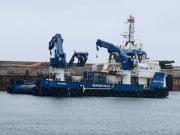
£10 million 'Isle of Jura' temporarily based at Gills Harbour in Far North of Scotland for her crew's debut tasks in the tidal-stream electricity field at the MeyGen sub-sea site, one mile off the little Caithness's port entrance channel. One of the UK's most modern marine renewables service vessels made her debut calls at community-owned Gills Harbour, near John O'Groats, over the 2021 Spring Equinoctial weekend.
Busy Gills Harbour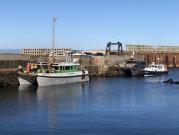
Its been a busy few days at local community-owned Gills Harbour ..... sometimes in suberb sunny weather as here ...
Energy Developments Continue at Gills Harbour and the Pentland Firth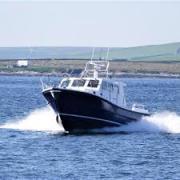
The company behind the world-leading tidal-stream prototype power plant in the Pentland Firth's Inner Sound is set to start manufacturing a new-style turbine that is hopes will reduce the project's generating costs. Simec Atlantis Energy (SAE) and a privately-owned specialist engineering firm from Spain's Bay of Biscay coastline have jointly been conducting 'research and development' (R& D) on the project for almost a year and are now ready to give it the go-ahead.
New Generation of office-bearers set to step up at Gills Harbour Ltd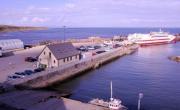
A new generation of younger local folk look set to take over the reins of running Gills Harbour Ltd, the local company that owns and operates the busy little port on the shores of the Pentland Firth's Inner Sound that holds its AGM this Saturday (10.10.20) morning at 10:00 am. The influx of younger blood comes after two key directors of the group that had run 'Canisbay's Peoples Port' both announced their retirement from office, whilst another Gills Harbour Ltd (GHL) office-bearer has declined to seek re-election.
MV Alfred And MV Pentalina Together At Gills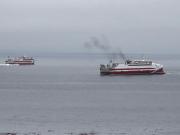
An 'old friend' returns to Gills Bay after an absence of manymonths. The 2,400 tonne 70 m.
Normand Cutter, The Norwegian-owned Offshore Construction Vessel at Gills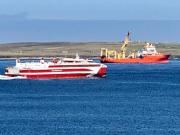
Here is the Normand Cutter, the Norwegian-owned offshore construction vessel that has been the base for works on Simec Atlantis Energy's (SAE's) MeyGen site in the Pentland Firth's Inner Sound, off Gills Bay during the current neap-tide sequence, that has lasted most of the week commencing 11.08.20. Picture by retired C of S Kirk Minister the Rev Lyall Rennie, who lives at Lower Warse, Canisbay, on the shores of Gills Bay..
New Ferry For Pentland Ferries Arrives Safely
Scotland's most modern + environmentally-friendly, fuel-efficient ROPAX ferry ship rge MV Alfred, arrived AM today (Wed 09.10.19 at St Margarets Hope. The boat went round to Kirkwall immediately at the end of 9,000+ miles voyage from the Strategic Marine yard near Ho Chi Minh city (ex.
Gills Harbour Ltd Awards Contract To Local Firm
Gills Harbour Ltd, the community-owned body that owns & operates the busy little port on Caithness's North Coast, has awarded a remedial contract to a Wick-based company. The deal, won in a competitive tender, has gone to builders/civil engineers Messrs GMR Henderson Ltd, of Martha Terrace in Wick.
